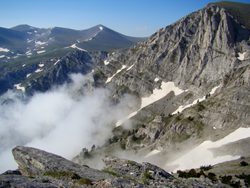
Quick Navigation
Olympus National Park is located in Greece. The national park encompasses an area of 92 square miles (238 sq km) and serves as one of the country's leading attractions.
Mount Olympus is the pinnacle attraction and heart of the national park. It represents cultural, historical, and natural significance. The summit reaches a height of 9,570 feet (2,917 m) with Mytikas being the highest of the peaks on the mountain. Mount Olympus is the highest mountain in Greece.
There are 52 different peaks spread out across the mountain. Mytikas is the one that hits the highest point at 9,570 feet (2,917 m). It is also one of the higher peaks throughout Europe. There are also deep gorges found within the mountain prominence.
Predator wildlife includes wolves, jackals, foxes, and wild cats. Some of the other larger mammal species include chamois, wild goat, and roe deer. Birdwatchers can keep an eye for the peregrine falcon, sparrow hawk, golden eagle, short-toed snake eagle, lanner falcon, and the booted eagle.
The national park honors and protects history, culture, and nature. Mount Olympus, which is the tallest mountain in Greece, is the home of the Twelve Gods of antiquity and of course the most famous god, Zeus.
Highlights
Mount Olympus and the surrounding area is the country’s most significant and valued national park. It represents the divine history, culture, and nature. Climbing and hiking Mount Olympus is a trek back in time and a hike amongst the gods of the Greek. While you take in the majestic nature of the stunning alpine terrain, you can also imagine back to what it was like for the Greeks who believed this mountain was home to their gods.
 Mount Olympus
Mount Olympus
Mount Olympus is the highest summit in Greece. There are 52 peaks across the massif with the tallest summit occurring at Mytikas. The highest elevation is 9,570 feet (2,917 m) above sea level. The prominence makes it one of the higher peaks of Europe.
Mount Olympus is the main attraction of the national park. The region has also been declared a World Biosphere Reserve. Wind and rain eroded the mountain creating a sheer towering characteristic.
The circumference of the mountain is 93 miles (150 km) and covering 190 square miles (500 sq km) of the area. That is one massive mountain. It's no wonder people believed it was the home of the 12 olympian gods.
Olympus National Park Trails
There are several trails and treks ranging from easy to more difficult and even dangerous. The majority of trails are looking to engage you with the mountain and mountainous areas.
Olympus Highlights
- Mount Olympus
- Mytikas
Park Map
Sources
- Britannica, Mount Olympus, https://www.britannica.com/place/Mount-Olympus-mountain-Greece, retrieved June 2020.
- Discover Greece, Olympus Where the Gods Still Reign, https://www.discovergreece.com/en/mainland/macedonia/olympos, retrieved October 2019.
- Greek Mythology, Mount Olympus, https://www.greekmythology.com/Myths/Places/Mount_Olympus/mount_olympus.html, retrieved June 2020.
- National Geographic, Mount Olympus National Park, https://www.nationalgeographic.com/travel/parks/olympus-greece/, retrieved October 2019.
- Olympus, Olympus National Park Information, https://olympusfd.gr/, retrieved October 2019.
- Climb Europe, Walking Around Mount Olympus National Park, https://www.climb-europe.com/WalkingGreece/Mount-Olympus-Walking.html, retrieved October 2019.













